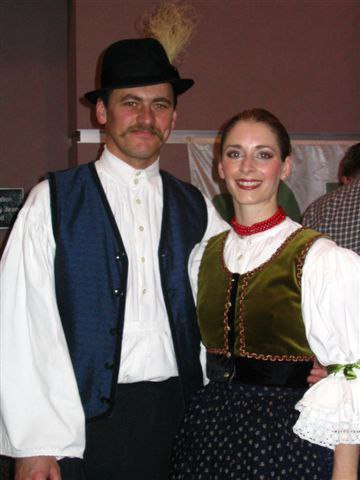|
 |
|
|
 |
 |
Some folks just seem to have more fun, or at least it seemed that way when the Hungarian State Folk Ensemble danced at the Center for Performing Arts. The large group of male and female dancers performed at full tilt for nearly two hours, creating an afternoon of one of the happiest entertainments imaginable. "Hymn" ("God, bless the Hungarians"), the national anthem of Hungary, is a clue to the seriousness this People gives to their national identity. Both parts of the program, "From Father to Son" and "Our Treasures," by their titles alone, affirmed the ensemble's pride in their heritage. As many dance presentations seem to do lately, a film clip played at the back of the stage. At first, the black and white film showed sand animation, in which a hand traced an eye, then a sun, then a bird in the sand. Throughout the dance program, a film of fields, tree branches, cracked earth, grain, and water referenced the rural settings, from which the dances originated. Hungarian dance is lively, energetic, and athletic to say the least. Representations of styles from regions throughout the country featured men dancing by themselves and women dancing in their own groups, but, mostly, men and women danced together in pairs, breaking apart to feature one or the other and then reuniting. The dances themselves put the focus on lower body movement, often with the dancers' arms held at shoulder height and bent like the branches of a candelabra. Men specialized in knees bent to the side while jumping, slapping thighs and knees, heel digs, and what apparently was competition with the other men to show off their best moves. Irish dancing and African American stepping use similar techniques! Women seemed to work together to show off group patterns rather than individual accomplishment. The one special exception to this was a solo dance in which one woman balanced a carafe filled with red liquid on her head. Of course, she didn't spill a drop! Women uniformly wore traditional bell skirts and petticoats that flared as they spun around, revealing colored or white opaque stockings. Vests fitted close to the body and beautiful lawn blouses completed the garb. The fabrics were densely printed or richly colored and embellished. Watching the swirl of color in the densely printed and richly colored fabrics was like looking through a kaleidoscope. All the women pulled their hair back sleekly into a single long braid that hung low on their back. They wore utilitarian knee high black boots or low-heeled dance shoes, though in one number some managed their fast-paces in mules! Men wore black pants, vests or suit jackets, and white blousy shirts with flowing sleeves and brimmed hats. In one number everyone was dressed in black and white, so as not to detract from the movements, as the managing director, Mária Ferencz related to me during an earlier interview. In another number, several of the men wore gathered white skirts similar to the traditional Greek military dress. When men and women danced together they conveyed a palpable sense of joy that seemed to flow from the partnering, the music, and the dance itself. Yet, they were dancing as pieces of the pattern of choreography, even though they held one another around the waist and on the shoulder, each clearly enjoying their partner. The pairs circled with the group in choreographed movements, broke apart, did some solo work, and came together again, all at a furious pace, whipped on by the ever faster and faster musical accompaniment. During featured dancing they called out to one another, "Go on! You can do it. You are my lover!" Or so I was told by one of the performers during intermission. Anyone who's heard so-called gypsy music with the violin fingering moving so fast that the notes blur, can have an inkling of the virtuoso playing demonstrated. Klezmer music, with the wailing clarinet and soulful sound, conveys the same spirit as the notes move ever faster, whipping the dancers to a frenzy. Such was the effective synergy between the musicians and their dancers. Some instruments, vaguely familiar in shape and sound to a bagpipe, the "duda" and another resembling a floor model hammer dulcimer, perhaps a "cymbalon," added additional Hungarian soul to the mix. From the snippets of Hungarian language during intermission to the standing ovation and cheers given to the Hungarian State Folk Ensemble, the audience must have truly felt they were experiencing a little bit of Hungary.
Gergely Agócs, László Kelemen, István Pál, Ferenc Radics, Music Rita Furik, Gerzson Péter Kovács, Richárd Kökény, Gábor Mihályi, Mihály Richtarcsik, Choreographies Rita Furik, Edit Szûcs, Costumes Gerzson Péter Kovács, Lighting/Settings Bori Vilma Kovács, Graphics Zoltán Dénes, Digitart, Ernst Süss, Video Works Ferenc Cakó, Sand Animation László Kelemen, Music Coordinator Gerzson Péter Kovács, Assistant Director Gábor Mihályi, Director/Choreographer The Hungarian State Folk Ensemble, Performers István Pál, Ferenc Radics, Directors of the Orchestra Richárd Kökény, Chorus Leader Gabriella Bakos, Szilvia Nemes, Péter Varga, Assistants Gábor Mihályi, Artistic Director Ann Fink, Public Relations Jackie DeMarco, Assistant Public Relations
 Hungarian State Folk Ensemble Photo © & courtesy of Carol Fox & Associates |
|
 Hungarian State Folk Ensemble Photo © & courtesy of Carol Fox & Associates |
|
 Attila greeting People Photo © & courtesy of Susan Weinrebe |
|
 Attila and Katalin Photo © & courtesy of Susan Weinrebe |
|
 Attila of the Hungarian State Folk Ensemble Photo © & courtesy of Susan Weinrebe |
|
|
|






